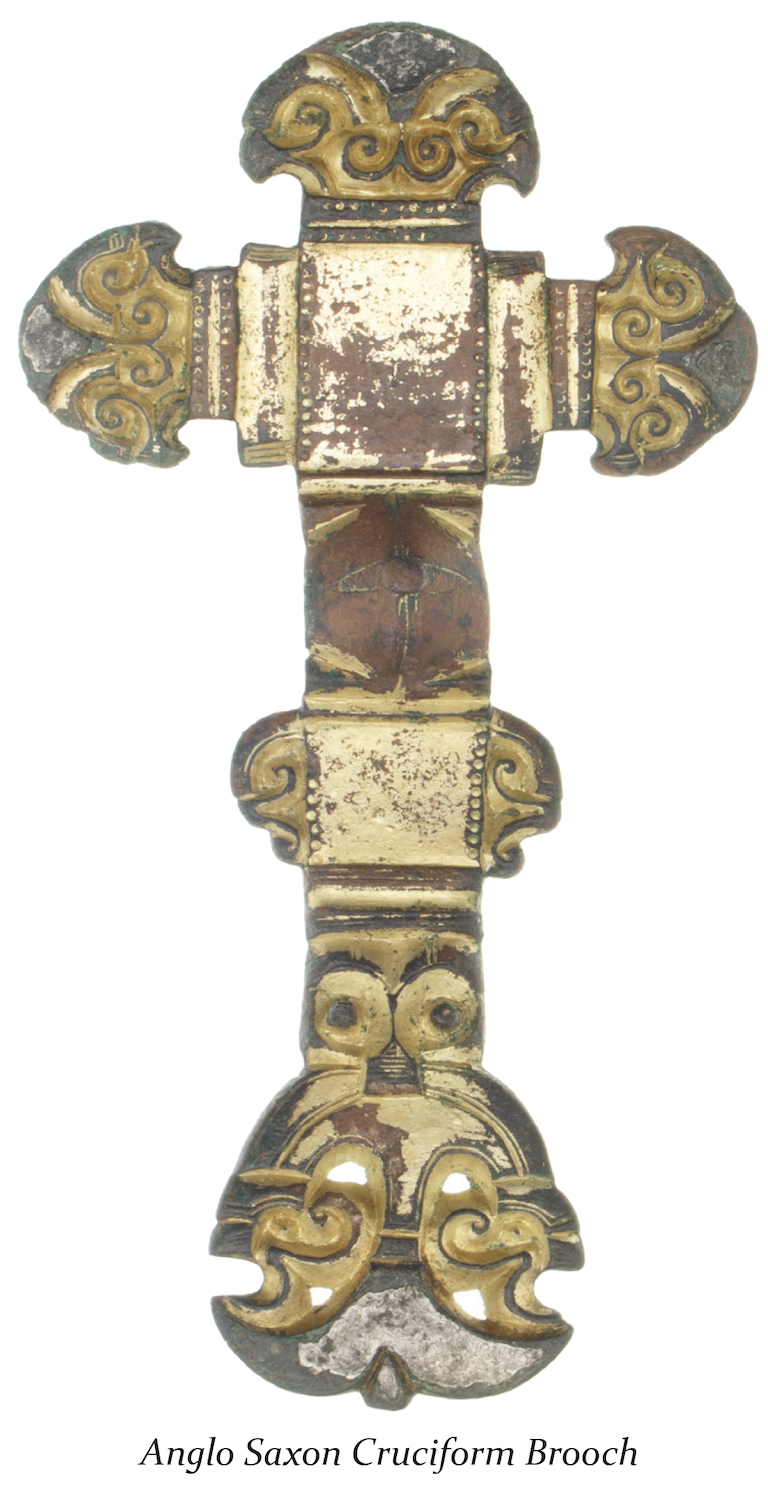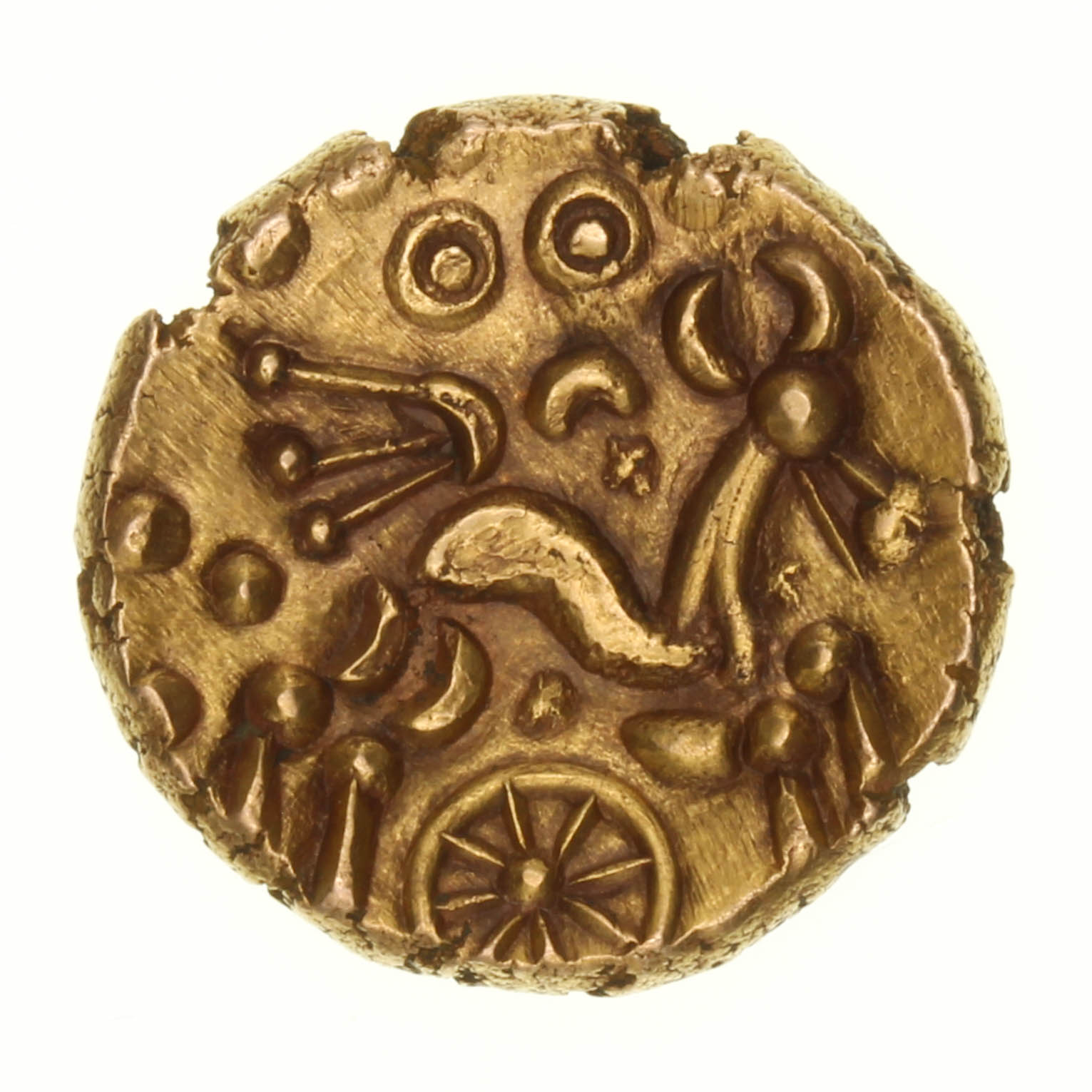
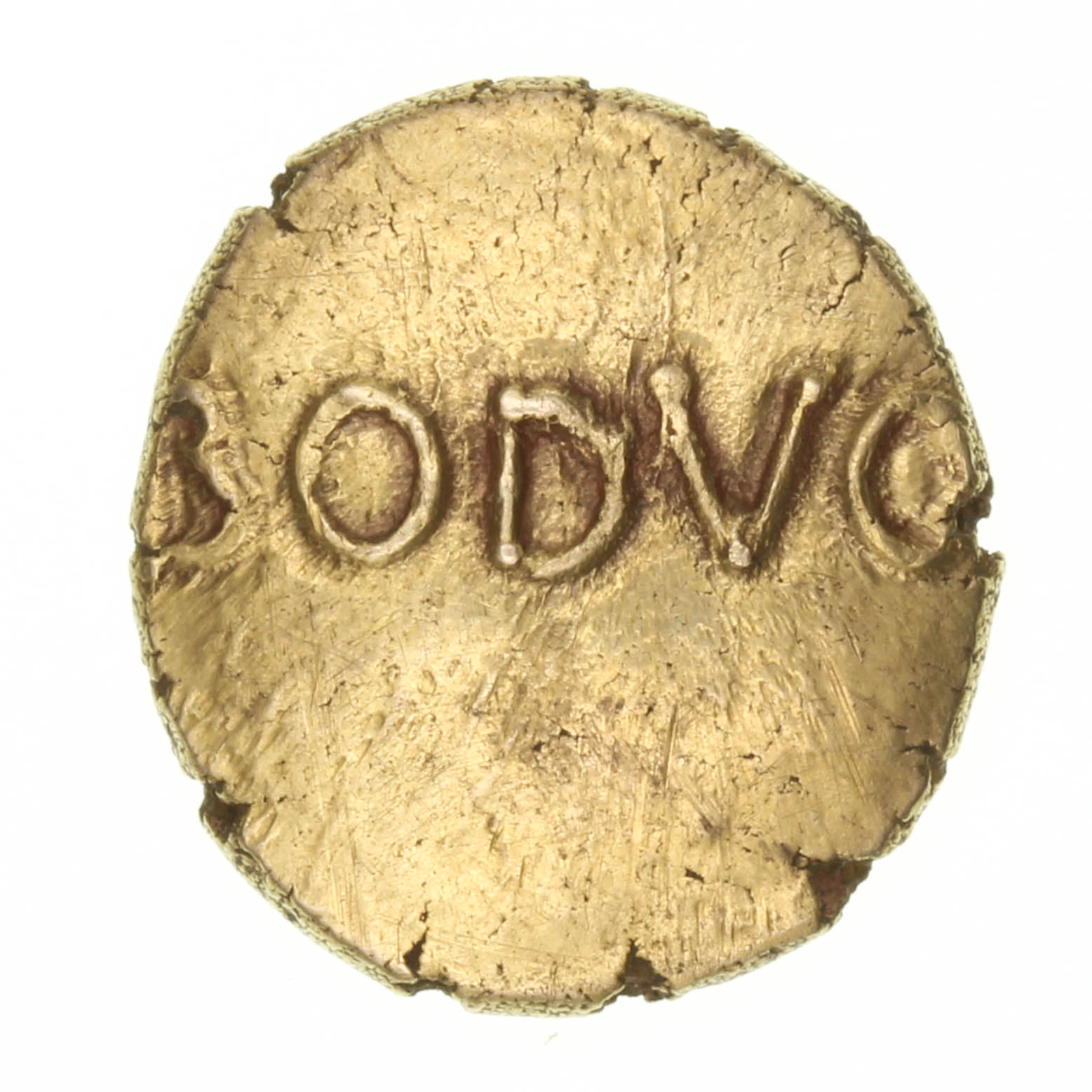
The Standlake Hoard of Boduoc Staters
Introducing the Standlake Hoard of Boduoc Staters. This hoard consists of 6 gold staters of the Dobunnic ruler Boduoc in exceptional condition. Found near the village of Standlake in Oxfordshire on organised metal detecting events during 2023. The finds were declared treasure and recorded with the Portable Antiquities Scheme and Celtic Coin Index, later disclaimed and returned to the finders and landowner. This gives private collectors the rare opportunity to secure a high grade rarity from the Ancient British inscribed series, seldom are coins of this quality found and offered for sale.
These coins will be offered for sale by auction ending at 5pm (GMT) on the 14th December 2024. Bidding is exclusively via Silbury Coins, on our website, by email or post using the downloadable bid sheet which can be found on the ‘Auction’ section using the navigation bar above.
For enquiries please contact us via email or phone:
info@silburycoins.com / 01242 898107
Introduction
This hoard consists of 6 gold staters of the Dobunnic ruler Boduoc in exceptional condition. Found near the village of Standlake in Oxfordshire on organised metal detecting events during 2023. The finds were declared treasure and recorded with the Portable Antiquities Scheme and Celtic Coin Index, later disclaimed and returned to the finders and landowner.
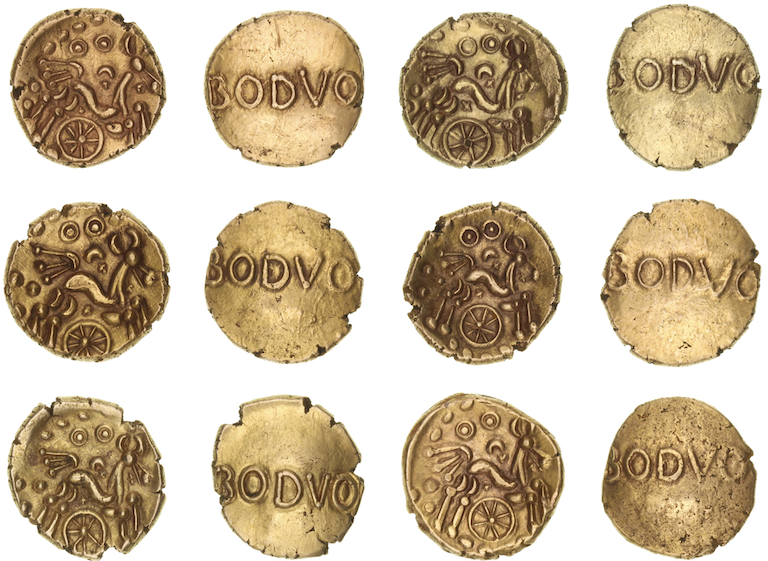
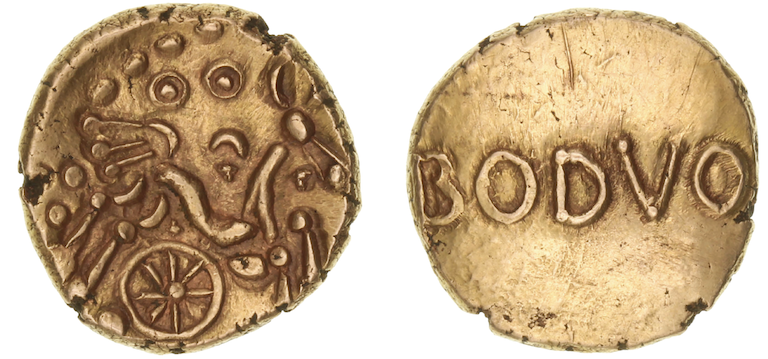
Lot 1
Estimate £2500-3000
Dobunni, Boduoc, 5 BC-AD 10, Gold Stater, BODVOC in plain field / Triple tailed horse right, wheel below, cross, crescent and two ringed-pellets above forming hidden face.
ABC 2039 (Rare), S388, VA1052, BMC 3135-42.
5.51g; 18mm
CCI 23.0545; PAS OXON-82F27C; Treasure case 2023 T567.
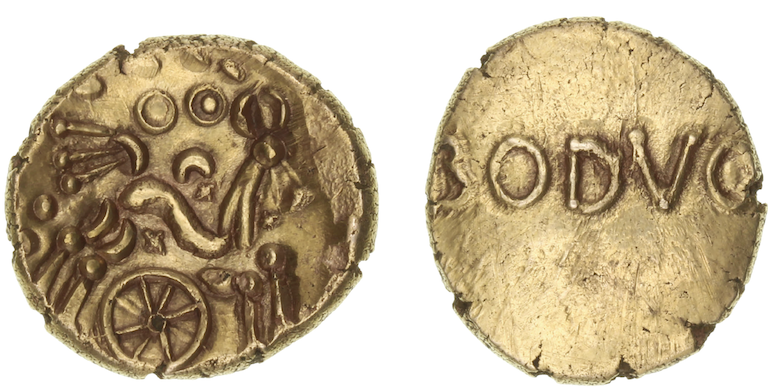
Lot 2
Not for sale as retained by finder
Dobunni, Boduoc, 5 BC-AD 10, Gold Stater, BODVOC in plain field / Triple tailed horse right, wheel below, cross, crescent and two ringed-pellets above forming hidden face.
ABC 2039 (Rare), S388, VA1052, BMC 3135-42.
5.45g; 18mm
CCI 23.0546; PAS OXON-82F27C; Treasure case 2023 T567.
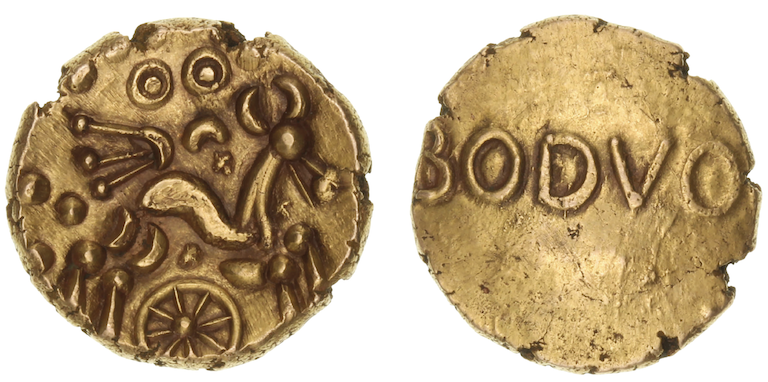
Lot 3
Estimate £2500-3000
Dobunni, Boduoc , 5 BC-AD 10, Gold Stater, BODVOC in plain field / Triple tailed horse right, wheel below, cross, crescent and two ringed-pellets above forming hidden face.
ABC 2039 (Rare), S388, VA1052, BMC 3135-42.
5.48g; 18mm
CCI 23.0547; PAS OXON-82F27C; Treasure case 2023 T567.
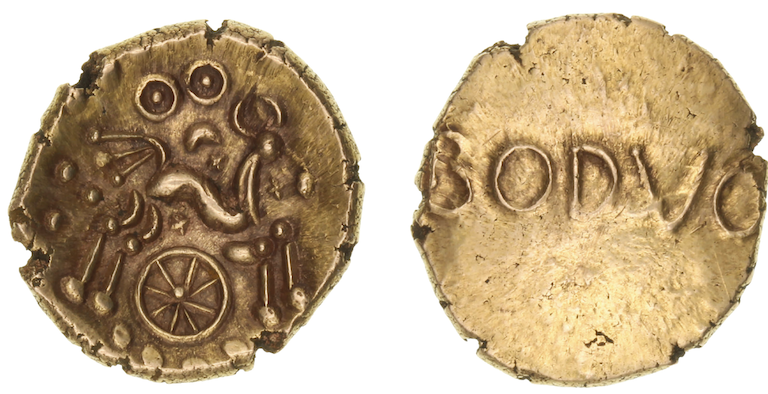
Lot 4
Estimate £2500-3000
Dobunni, Boduoc , 5 BC-AD 10, Gold Stater, BODVOC in plain field / Triple tailed horse right, wheel below, cross, crescent and two ringed-pellets above forming hidden face.
ABC 2039 (Rare), S388, VA1052, BMC 3135-42.
5.50g; 18mm
CCI 23.0548; PAS OXON-82F27C; Treasure case 2023 T567.

Lot 5
Estimate £2500-3000
Dobunni, Boduoc , 5 BC-AD 10, Gold Stater, BODVOC in plain field / Triple tailed horse right, wheel below, cross, crescent and two ringed-pellets above forming hidden face.
ABC 2039 (Rare), S388, VA1052, BMC 3135-42.
5.51g; 18mm
CCI 23.0549; PAS OXON-82F27C; Treasure case 2023 T567.
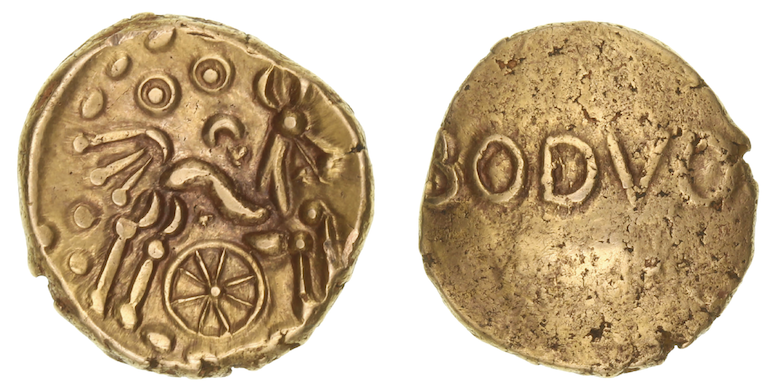
Lot 6
Estimate £2500-3000
Dobunni, Boduoc , 5 BC-AD 10, Gold Stater, BODVOC in plain field / Triple tailed horse right, wheel below, cross, crescent and two ringed-pellets above forming hidden face.
ABC 2039 (Rare), S388, VA1052, BMC 3135-42.
5.42g; 18mm
CCI 23.0552, PAS OXON-FB3D18
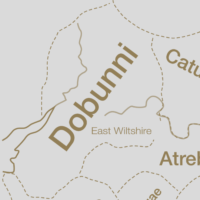
BACKGROUND TO THE DOBUNNI
In western England we find the Dobunni – their key zone of influence centred around the Cotswolds (specifically Gloucestershire, Worcestershire, parts of Oxfordshire) and lower Severn valley. Modern day Cirencester, called Corinium by the Romans, was likely the centre of the Dobunni tribe in its latter years. Initially the tribe established their base in a hill fort near the village of Bagendon a few miles north of the modern-day town.
The Roman historian Cassius Dio makes reference to the Dobunni in his ‘Roman History’ during the late 2nd/early 3rd Century AD.
‘Plautius…defeated first Caratacus and then Togodumnus, the sons of Cunobelinus who was now dead…. with these two put to flight Plautius secured the surrender on terms of part of the Bodunni (sic) who were subject to the Catuvellaunii.’ (Roman History, book LX, ch. 20, trans. Cary)
Assuming that Cassius Dio mistranscribed ‘Bodunni’, intending ‘Dobunni’, this indirect reference provides the earliest available to us regarding the name.
RULERS
No fewer than seven individuals appear to be named on coins attributed to the Dobunni, we have placed these in chronological order.
Corio 20 BC – AD 5?
‘Corio’ appears on inscribed staters and quarter-staters within western Britain. While his reasonably common staters follow the tree/horse pattern well established in the region as a standard motif combination, the quarter-staters are interesting in their use of the obverse to depict the name ‘COR[IO]’ on its own paralleled with the obverses of coins struck by another Dobunnic issuer – Boduoc.
Coins attributed to Corio cluster most strongly in modern-day Worcestershire and Warwickshire, with a smaller number from Gloucestershire and Oxfordshire.
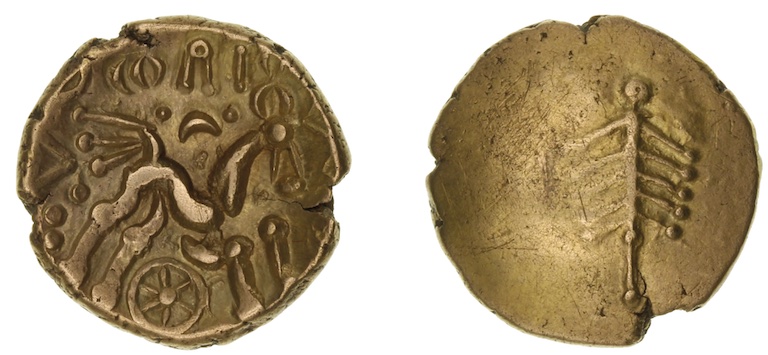
Boduoc 5 BC – AD 10?
Coins issued in the name of Boduoc are exceptional within the overall Dobunnic series. Their designs include elements which are unlike anything else in the region. No tree/horse gold staters were produced, the obverses instead depicting a pure textual rendering of his name in minimalistic style, while the silver units depicting profile heads find close comparison with Romaninfluenced coins of the eastern/north Thames region (see below). It has been proposed that Boduoc might not have been local explaining the very different overall ‘flavour’ of his coins, his silver especially bearing resemblance to that of the contemporary Catuvellaunian king Tasciovanus.
Boduoc’s coins are restricted to the English side of the river Severn – extending about as far eastwards as Wallingford. Their strongest showing is in Oxfordshire and Gloucestershire.
There are a total of 77 gold staters of Boduoc recorded, study of these coins reveals 37 different reverse dies which may suggest that Boduoc planned to be far more successful and reign for longer than he actually did.
Interestingly, the Standlake hoard comprises of uncirculated coins struck from 4 previously unknown reverse dies, suggesting a parcel of coins buried soon after they left the mint. Argument perhaps for this not being too far from the find spot.
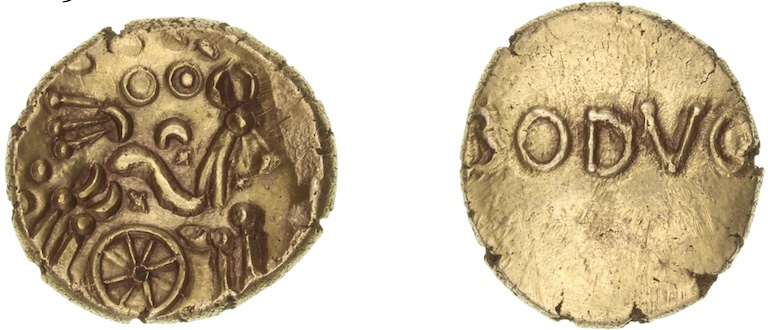
Comux AD 5-10?
Gold Dobunnic staters attributed to Comux are very rare finds indeed, with just 15 coins recorded via British institutions like the PAS and CCI. As with Catti and Corio, staters of Comux follow the well-known Dobunnic tree/horse format. However, one point of difference is that ‘COMVX’ is rendered upside down on the reverse, a unique feature amongst the inscribed Dobunnic gold coinage.
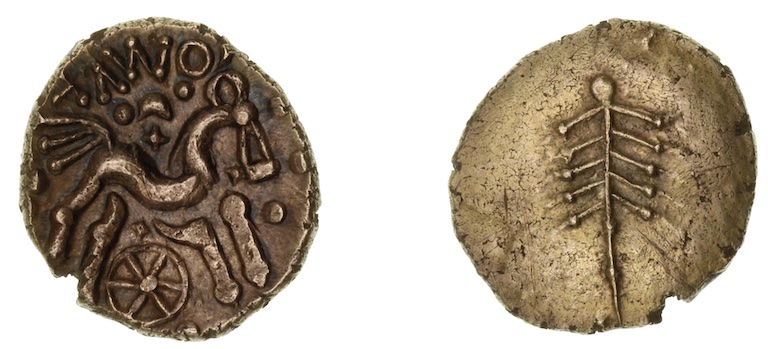
Catti AD 10-20?
Dobunnic coins struck in the name of Catti occur only on one type of gold stater, the typical tree/horse design. The single finds have a relatively dispersed pattern, mostly occurring around Worcester and Gloucester as well as down the Severn estuary on both the English and Welsh sides of the modern border.
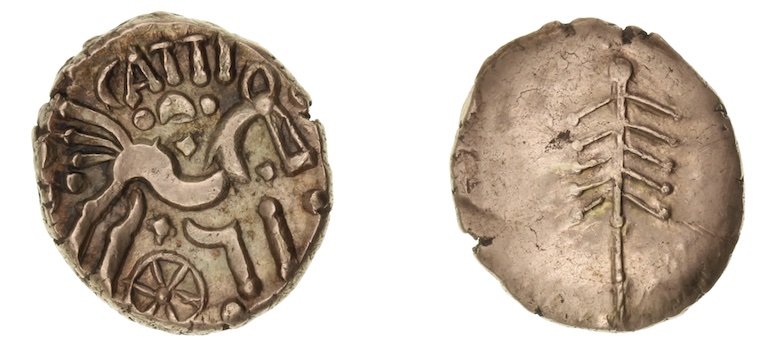
Imamn AD 10?
Only two coins of ‘Imamn’ are currently known to exist, suggesting that the overall issue was very small indeed. The bronze core of a plated gold stater was recovered from the hillfort at Hod Hill, Dorset, in the 1860’s – remaining unique for this issuer until the 2006 discovery of a silver unit from the vicinity of Cirencester. Given the lack of surviving coins, it is very difficult to say anything about their distribution based on just two pieces.
Anted AD 20-35?
‘Anted’ seems likely to represent an abbreviated version of the name Antedios – he who is ‘very fiery’ or ‘sits foremost’ in the Brittonic tongue. Just as with his coissuers, Anted struck gold staters, though these differ in the key respect that they often bear the additional abbreviations ‘RIC’, ‘RIGV’ or ‘RICOV’ after his name. This is often interpreted as a shortened version of the Brittonic word rigonos – translated as ‘king’. Notably, Anted also struck inscribed silver units, stylistically similar to the earlier uninscribed series.
Coins bearing the name ‘Anted’, have been found all over Dobunni territory, centred around Gloucestershire.
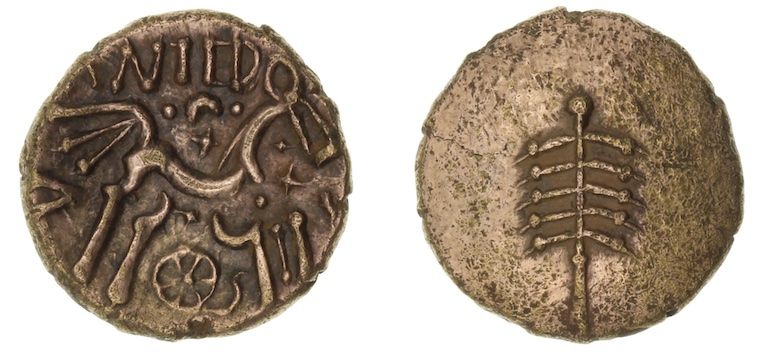
Eisu AD 30-43?
Another individual whose coins comprise both staters and silver units is Eisu. As with ‘Anted’, some of his gold coins also bear a secondary inscription reading ‘RICV’ – suggesting that he was also portraying himself as a king. The gold coins follow the usual Dobunnic model, while his silver is closely related to the style of Anted – though of slightly more degraded appearance.
Coins struck in the name of Eisu follow the relatively typical pattern evidenced with many other coins of Dobunnic affiliation, concentrating most strongly in and around Gloucestershire, Worcestershire and Oxfordshire.
Notably, coins of Eisu were also present in a mixed Late Iron Age/Roman hoard from Malpas, Cheshire, discovered in 2014. The entire group comprised 35 coins, of which 28 were Roman Republican and early Imperial denarii closing with pieces of Tiberius. The remaining 7 coins comprised western staters of Eisu and, significantly, inscribed north-eastern staters of the Corieltavi.
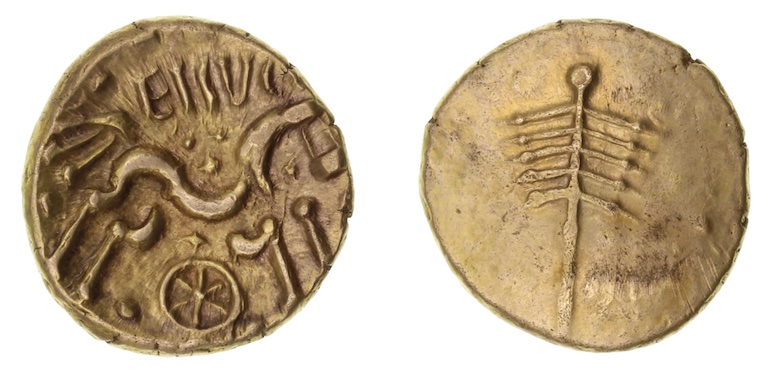
HISTORY OF STANDLAKE
The modern settlement of Standlake, Oxfordshire, sits at the junction of two rivers – the Thames and the Windrush. Such a low-lying, riverine setting probably explains the ancient origins of its name, translating in Old English as ‘stony stream’.
Occupation of the surrounding area can be dated back as far as approximately 450-400,000 years ago, given the recovery of numerous Palaeolithic handaxes and other flint tools from the surrounding area during gravel extraction. However, the majority of archaeological remains and finds discovered are of much later date – i.e. from the Bronze Age onwards. A significant group of Middle Bronze Age round barrows and a later settlement of the Early Iron Age were discovered on Standlake Downs during the later 19th century, being published in the county archaeological journal Oxoniensia.
Occupation seems to have intensified in and after the Middle Iron Age, the area being practically littered with cropmarks reflective of both settlement and agricultural exploitation in this period.
Artefacts of Iron Age date recorded from the parish generally date to the late 1st century BC or early 1st century AD, with significant numbers of western (Dobunnic) coin finds recorded. Such a concentration of Late Iron Age coinage within a small area is suggestive of the area having great significance during this period, perhaps connected in some way with its agricultural productivity.
The Iron Age to Roman transition appears to have had little effect on the area from an occupational point of view. A thriving Romano-British rural community of the 2nd-4th centuries AD is evidenced in particular to the west of the village and extended further upriver, its presence attested not only by excavation and cropmark evidence but also numerous finds recorded via the Portable Antiquities Scheme. Over one-hundred Roman coins have been logged from Standlake, accompanied by a smaller number of dress-related and personal items such as brooches and finger rings.
Coin-loss profiles from both this site and others in the region suggest a notable drop-off in activity at the end of the 4th century. This was perhaps associated with some kind of agricultural or population decline, though people by no means became absent from the landscape as Roman Britain ended and the ‘Dark Ages’ began. Indeed, that Standlake would later become part of a major royal estate suggests that it represented a key area for people who inhabited the region. No nearby settlement site appears yet to have been identified, but at least two Early Anglo-Saxon cemeteries are known from the vicinity, both resulting from antiquarian excavations of the later 19th century. A major group of over 80 graves was excavated in association with the Middle Bronze Age barrow group on Standlake Downs, while a second, smaller cemetery was situated near Malthouse Farm in neighbouring Brighthampton. Both these sites produced a wide range of finds typically associated with the furnished burials of this period, including weaponry, brooches, amber beads and gilt harness mounts.
